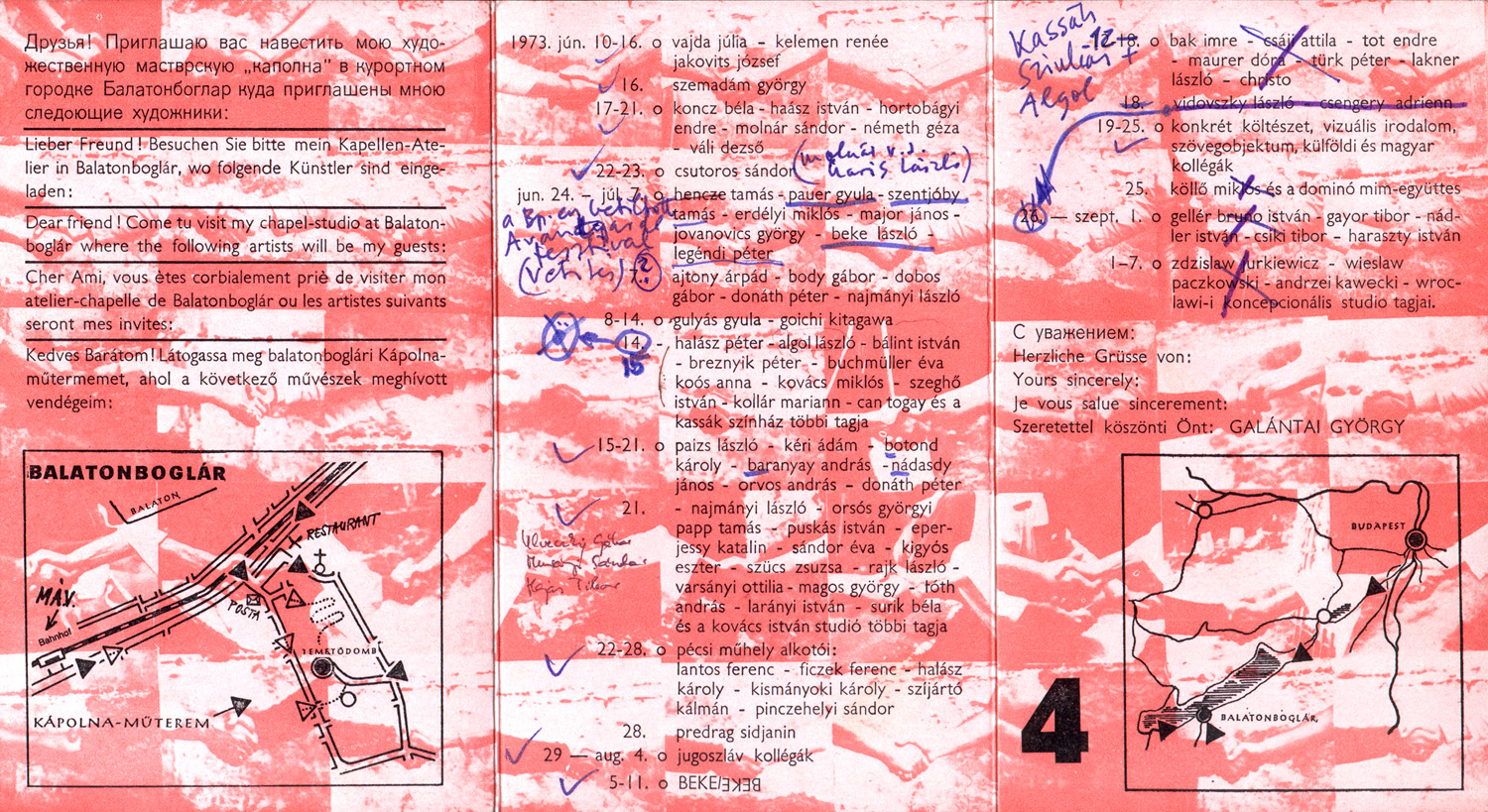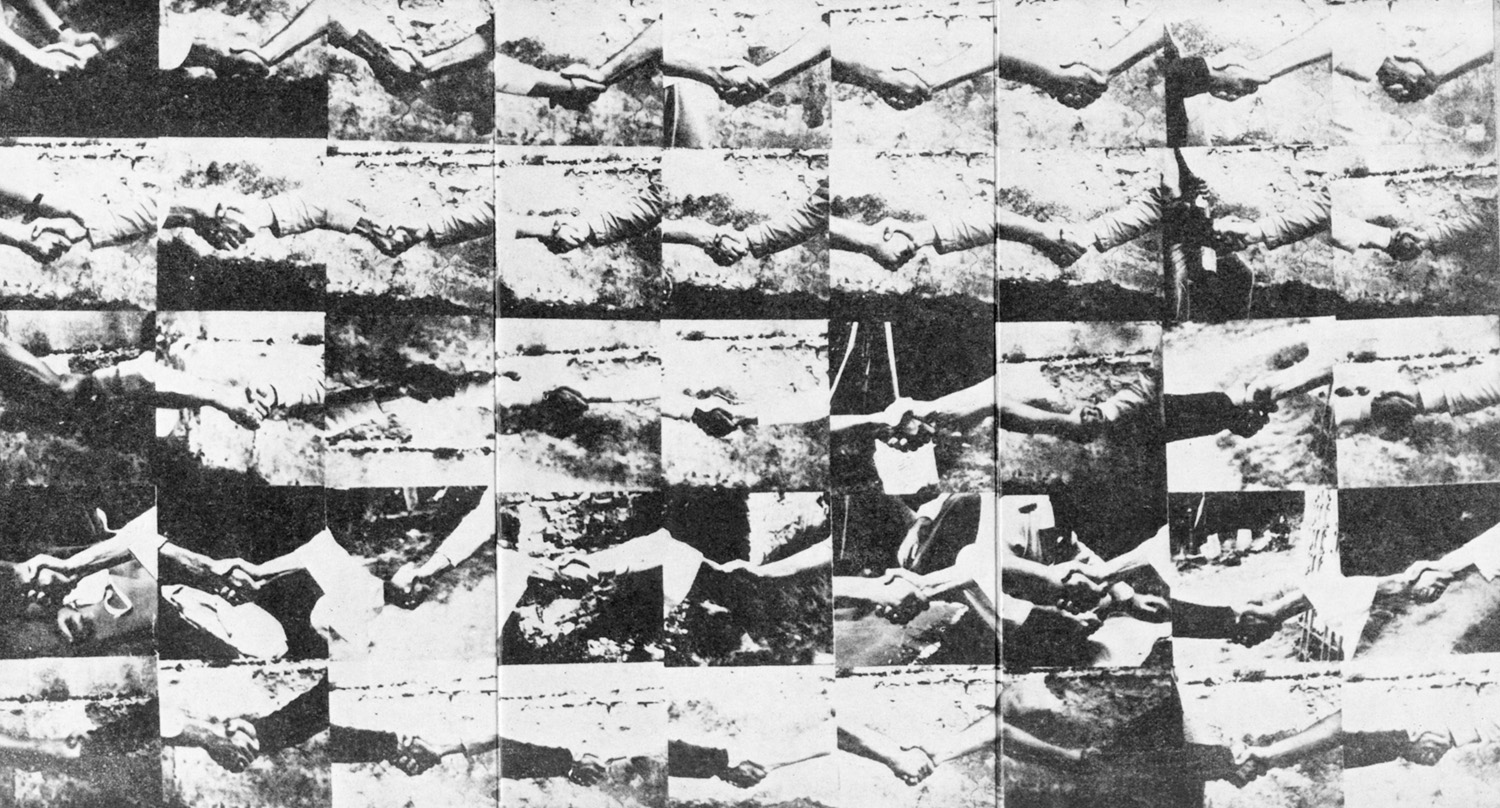Artpool Balatonboglár Chapel Studio


Ort
-
Budapest, Szabolcs utca 33
Auf Karte anzeigen
Sprachen
- Deutsch
- Englisch
- Französisch
- Italienisch
- Spanisch
- Ungarisch
Name der Sammlung
- Chapel Studio, Balatonboglár (1970–1973) – collection of artworks and documents
Sammlungsgeschichte und kulturelle Aktivitäten
Inhaltsbeschreibung
Inhalt
- Artefakte: 500-999
- Erinnerungsstücke (Poster, Flyer, Briefmarken, etc.): 1000-
- Fotos: 1000-
- Tonaufnahme: 100-499
Betreiber
Geographische Reichweite der Sammlung
- international
Schöpfer/in
Gründungsdatum
- 1968
Gründungsort
-
Budapest, Frankel Leó út 68/b.
Auf Karte anzeigen
Autor
Sammler
Wichtige Ereignisse in der Geschichte der Sammlung
- Tamás Szentjóby: Parallel-course Study Track, July 1, 1971 (Initiation ritual)
- Direct Week, July 6-9, 1972
- Meeting of Czech, Slovak and Hungarian artists, Balatonboglár, 1972
- “Happening in the Crypt” by László Szabó, 1973.
- Katalin Ladik’s sound poetry performance, Balatonboglár, 1973
- Kassák Theatre: King Kong, 1973
- Tükör / Mirror / Spiegel / Miroir, 1973
- Szövegek / Texts, 1973
Besondere Beispiele
- Action Tableau of shaking hands, 1972. Work of art
- Erdély, Miklós, Jovánovics, György, Major, János. János Major’s coat, 1973. Work of art
- Erdély, Miklós. Poetry as a Self Assembling System, 1973. Work of art
- Major, János. Living Tombstone, 1973. Performance documentation
- Once we went, 1972. Photo series
- Work Diary of the Chapel Studio, 1972.
Zugangsart
- Zugang nach Vereinbarung
Veröffentlichungen
AutorIn des Eintrags
- Barkóczi, Flóra
- Klaniczay, Júlia
Literaturverzeichnis
Hajdu, István: Illegal Avant-garde: The Balatonboglár Chapel Studio of György Galántai 1970–1973, Praesens, No. 3., 2003 November, pp. 114–118.
Hegyi, Dóra – Hornyik Sándor – László Zsuzsa (eds.): Parallel Chronologies. How art becomes public – “Other” revolutionary traditions. An exhibition in newspaper format, tranzit.hu, Budapest, 2011, 56 p.
Sasvári, Edit: A Moment of Experimental Democracy in the Kádár Era. György Galántai’s Chapel Studio in Balatonboglár and the Social Milieu of Counter-Culture in Hungary in the 1960s and 1970s, in: Removed from the Crowd: Unexpected Encounters I, [BLOK] – DeLVe, Zagreb, 2011, pp. 82–101.
Hock, Beata: Where Have Some Women Gone? Making Women Artists’ Networks Visible, in: Micropolitics Notebook 2011, [BLOK], Zagreb, 2011, pp. 38–47.
Hegyi, Dóra et al. (eds.): Art Always Has Its Consequences – Artists’ Texts from Croatia, Hungary, Poland, Serbia, 1947–2009, tranzit.hu – Sternberg Press, Berlin, 2011, 262 p.
Tumbas, Jasmina: International Hungary. György Galántai’s networking strategies, ARTMargins, Vol. 1., Issue 2–3., 2012 (June–October), pp. 87–115.
Herczog Noémi: Ha kell – tiltsunk! Feljelentő színházkritika a hetvenes években, 2000, 2005/7, pp.14-28.
Radomska, Magdalena: Polityka Kierunków Neoawangardy Węgierskiej (1966-1980), Universitas, Krakkó, 2013, 548 p.
Serban, Alina – Stefania Ferchedau: We Are Always Working on the Roots... Interview with György Galántai and Júlia Klaniczay, Artpool, institutulprezentului.ro, 16 September 2017
https://institutulprezentului.ro/en/2017/09/16/artpool/
Kürti Emese: Screaming Hole. Poetry, Sound and Action as Intermedia practice in the work of Katalin Ladik, acb Research Lab, Budapest, 2017, pp. 144, 146, 215, 237, 248.
Forgács Éva: Hungarian Art: Confrontation and Revival in the Modern Movement, Doppelhouse Press, Los Angeles, 2016, pp. 168-171, 175, 276, 294.
Krasteva, Snejana: I Know You Are Here Reading But You Have No Idea Where I Am, n: Grammar of Freedom/Five Lessons. Works from the Arteast 2000+ Collection Moderna galerija, Ljubljana, Garage Museum of Contemporary Art, Moscow, 2015, pp. 24-27.
Fowkes, Maja: The Green Bloc. Neo-avant-garde Art and Ecology under Socialism, Central European University Press, Budapest-New York, 2015, 299 p-
Kemp-Welch, Klara: Antipolitics in Central European Art. Reticence as Dissidence under Post-Totalitarian Rule 1956-1989, I.B.Tauris, London-New York, 2014, 336 p.
[film] Vakáció I–II. A Balatonboglári Kápolnatárlatok története 1970–1973 [Vacation. The Story of the Chapel Studio of Balatonboglár 1970–1973], 1997–1998, 52+54 min.; and a 66 min. version with English subtitles, dir. by Árpád Soós, edited by Róbert Római, script and reporter: Edit Sasvári, Magyar Televízió Dokumentumfilm Stúdió